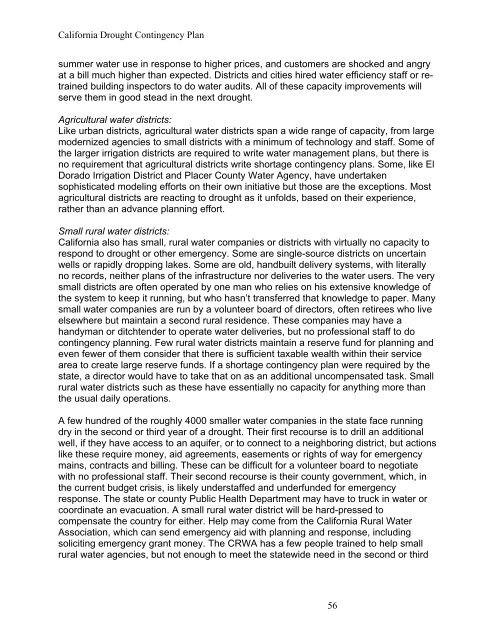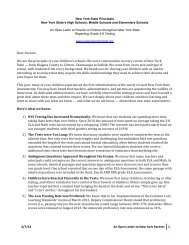Final_CA_Drought_Contingency_Plan-11-18-2010a
Final_CA_Drought_Contingency_Plan-11-18-2010a
Final_CA_Drought_Contingency_Plan-11-18-2010a
You also want an ePaper? Increase the reach of your titles
YUMPU automatically turns print PDFs into web optimized ePapers that Google loves.
California <strong>Drought</strong> <strong>Contingency</strong> <strong>Plan</strong>summer water use in response to higher prices, and customers are shocked and angryat a bill much higher than expected. Districts and cities hired water efficiency staff or retrainedbuilding inspectors to do water audits. All of these capacity improvements willserve them in good stead in the next drought.Agricultural water districts:Like urban districts, agricultural water districts span a wide range of capacity, from largemodernized agencies to small districts with a minimum of technology and staff. Some ofthe larger irrigation districts are required to write water management plans, but there isno requirement that agricultural districts write shortage contingency plans. Some, like ElDorado Irrigation District and Placer County Water Agency, have undertakensophisticated modeling efforts on their own initiative but those are the exceptions. Mostagricultural districts are reacting to drought as it unfolds, based on their experience,rather than an advance planning effort.Small rural water districts:California also has small, rural water companies or districts with virtually no capacity torespond to drought or other emergency. Some are single-source districts on uncertainwells or rapidly dropping lakes. Some are old, handbuilt delivery systems, with literallyno records, neither plans of the infrastructure nor deliveries to the water users. The verysmall districts are often operated by one man who relies on his extensive knowledge ofthe system to keep it running, but who hasn’t transferred that knowledge to paper. Manysmall water companies are run by a volunteer board of directors, often retirees who liveelsewhere but maintain a second rural residence. These companies may have ahandyman or ditchtender to operate water deliveries, but no professional staff to docontingency planning. Few rural water districts maintain a reserve fund for planning andeven fewer of them consider that there is sufficient taxable wealth within their servicearea to create large reserve funds. If a shortage contingency plan were required by thestate, a director would have to take that on as an additional uncompensated task. Smallrural water districts such as these have essentially no capacity for anything more thanthe usual daily operations.A few hundred of the roughly 4000 smaller water companies in the state face runningdry in the second or third year of a drought. Their first recourse is to drill an additionalwell, if they have access to an aquifer, or to connect to a neighboring district, but actionslike these require money, aid agreements, easements or rights of way for emergencymains, contracts and billing. These can be difficult for a volunteer board to negotiatewith no professional staff. Their second recourse is their county government, which, inthe current budget crisis, is likely understaffed and underfunded for emergencyresponse. The state or county Public Health Department may have to truck in water orcoordinate an evacuation. A small rural water district will be hard-pressed tocompensate the country for either. Help may come from the California Rural WaterAssociation, which can send emergency aid with planning and response, includingsoliciting emergency grant money. The CRWA has a few people trained to help smallrural water agencies, but not enough to meet the statewide need in the second or third56






